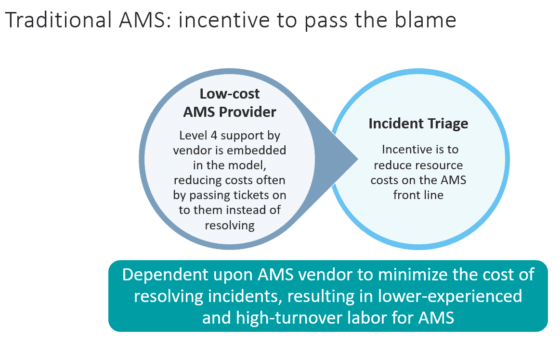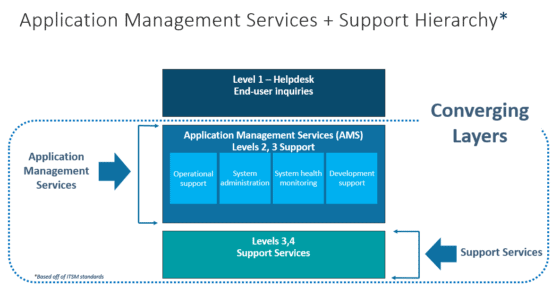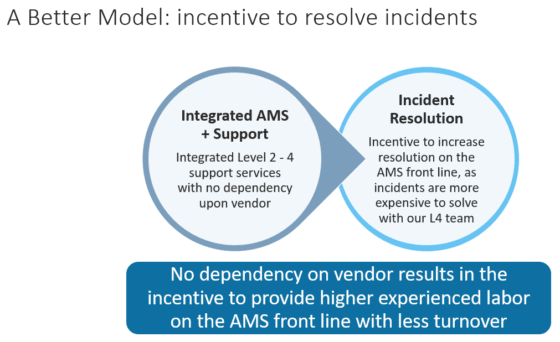
Why is outsourcing Application Management Services (AMS) so complicated, and why doesn’t it work like it’s supposed to?
The AMS concept is simple: offload incidents, service requests, routine tasks, and IT backlogs so that internal teams are free to focus on game-changing initiatives. But the reality? Too many man-hours, yet nothing seems to get done; and the internal team spends its time overseeing a multitude of vendors and service-level agreements (SLAs), mediating disputes, and managing escalations — rather than fueling innovation.
So why do companies continue to spend on services that seem like a very expensive black hole — consuming both budget and the internal teams they are meant to set free? Perhaps it’s because companies don’t know that a much better alternative exists.
The Traditional AMS Support Model is Broken
There are many problematic aspects to the current, industry-accepted AMS support model. The model is outdated and complex, with segregated application management and support layers within a time and materials contract structure and a “man-hours” billing system. There is no provision or measurement of incident resolution, just available banks of hours and billable time of staff for “incident handling.”
Problems with this model have been well-known for years — leaving companies with bloated AMS agreements originally negotiated based on continuous upgrade cycles. But what if they are in a steady state? It is important to note that AMS and their evaluation have shifted over time. Historically, SLAs steer the agenda as costs and output were measured against them, as opposed to considering ROI.
Moreover, some AMS vendors underprice their services and use low-cost, inexperienced, high-turnover resources with ITIL Level 4 ERP vendor support embedded in their model. The result is poor, inconsistent AMS service.
In this situation, AMS vendor resources are incentivized to reduce costs on the AMS front line by triaging support tickets to the ERP vendor rather than resolving them. Given the challenges that many organizations have with ERP vendor support, the very same problems they are paying the AMS vendor to solve, are instead boomeranged back to the internal IT team.

For these vendors, AMS is a loss leader offset by expensive new consulting, project, and development work that commences inconspicuously as the provider learns more about a client’s digital agenda. This is known as a “land and expand” approach manifested by change requests, continuous upgrades, and scope creep, with the IT team potentially paying more — or paying again — for what the organization already owns.
In this scenario, a client may begin to hear imaginary cash register sounds and vendor observations such as:
- “That service is out of scope …”
- “You will need a new release to be able to do that …”
Given this context, it is no surprise that the traditional AMS model is not delivering on functional priorities and is instead actually contributing to operational drag and a bloated IT backlog — the very issues it intends to resolve. It is also no surprise that AMS vendors have poor service ratings, with Gartner citing a 3.03/5.00 rating for ‘top’ AMS companies, and that there is a downward trend of AMS vendor customer satisfaction.[1] IT teams must be asking themselves, “Are we getting actual value from our AMS services, or just hours and hours of ‘trying’ plus manufactured project and consulting work?
There is a Better Way
Resolving incidents is the solution, not running up more and more man-hours of inexperienced or ERP vendor labor to address incidents. By definitively resolving each incident, companies can actually reduce the total number of incidents, service requests, or even routine tasks per year, improving business outcomes and the total cost of ownership.
Within this context, a highly integrated AMS + support catalog predicated on incident resolution, not man-hours, is a better option. In this model, AMS services have converging layers that are tightly integrated with ITIL Levels 2-4 support, with no embedded ERP vendor dependency.

This model is the opposite of the traditional AMS model. Here, individuals and teams resolve incidents, and are incentivized to reduce overall AMS costs by increasing incident resolution on the AMS front line rather than triaging to more expensive L4 support resources.

Providers with this model employ highly skilled labor for AMS services — and for support services — and have clearly defined career paths and high retention rates. Engagement managers work collaboratively with primary support engineers and enterprise account managers to resolve incidents. The primary focus is on delivering client success and client satisfaction through exceptional service that culminates in incident resolution.
Benefits of the Integrated AMS + Support Model
There are many advantages of the integrated AMS + support model versus the traditional AMS model:
- Incidents are resolved more quickly and more efficiently
- The IT team is freed up to work on projects that drive revenue
- Support is simplified, with no manufactured project work
- Support is strategic and proactive versus reactive
- Resources are highly skilled, experienced, and accountable
- Resources are evaluated and compensated on client satisfaction
- The focus is on eliminating backlog and driving the value and longevity of existing systems
- Operational productivity is improved; operational drag is removed
- Unnecessary costs are removed from the business, and there is no running up of man-hours
- Budget, resources, and time savings are unlocked to fuel innovation
With such an integrated support model, providers can help organizations maximize the lifespan and value of their current IT investments. When compared to the traditional AMS model, the integrated support model is a much better fit for meeting a modern enterprise software’s functional, operational, and business priorities.
AMS shouldn’t be about overpaying for man-hours anymore. It should be about smart, efficient incident resolution, improving operational productivity, and freeing up valuable IT teams for more critical business initiatives that drive innovation and growth.
To learn about Rimini Street’s full range of integrated AMS + support services for SAP, Oracle, and Salesforce®, visit the AMS section of our website.
1Tech Mahindra “Critical Capabilities for Oracle Application Services, Worldwide.” February 28, 2018. https://www.techmahindra.com/ebs/docs/critical-capabilities-for-or-340231-Gartner-Oracle.pdf


